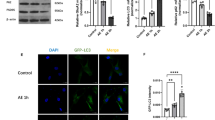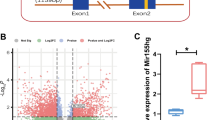Abstract
The activation of c-Jun-N-terminal kinases (JNK) pathway has been largely associated with the pathogenesis and the neuronal death that occur in neurodegenerative diseases. Altogether, this justifies why JNKs have become a focus of screens for new therapeutic strategies. The aim of the present study was to identify the role of the different JNK isoforms (JNK1, JNK2, and JNK3) in apoptosis and inflammation after induction of brain damage. To address this aim, we induced excitotoxicity in wild-type and JNK knockout mice (jnk1 −/−, jnk2 −/−, and jnk3 −/−) via an intraperitoneal injection of kainic acid, an agonist of glutamic-kainate-receptors, that induce status epilepticus.
Each group of animals was divided into two treatments: a single intraperitoneal dose of saline solution, used as a control, and a single intraperitoneal dose (30 mg/kg) of kainic acid. Our results reported a significant decrease in neuronal degeneration in the hippocampus of jnk1 −/− and jnk3 −/− mice after kainic acid treatment, together with reduced or unaltered expression of several apoptotic genes compared to WT treated mice. In addition, both jnk1 −/− and jnk3 −/− mice exhibited a reduction in glial reactivity, as shown by the lower expression of inflammatory genes and a reduction of JNK phosphorylation. In addition, in jnk3 −/−mice, the c-Jun phosphorylation was also diminished.
Collectively, these findings provide compelling evidence that the absence of JNK1 or JNK3 isoforms confers neuroprotection against neuronal damage induced by KA and evidence, for the first time, the implication of JNK1 in excitotoxicity. Accordingly, JNK1 and/or JNK3 are promising targets for the prevention of cell death and inflammation during epileptogenesis.












Similar content being viewed by others
References
Davis RJ (1999) Signal transduction by the c-Jun N-terminal kinase. Biochem Soc Symp 64:1–12
Zdrojewska J, Coffey ET (2014) The impact of JNK on neuronal migration. Adv Exp Med Biol 800:37–57. doi:10.1007/978-94-007-7687-6_3
Ventura J-J, Hübner A, Zhang C et al (2006) Chemical genetic analysis of the time course of signal transduction by JNK. Mol Cell 21:701–710. doi:10.1016/j.molcel.2006.01.018
Gupta S, Barrett T, Whitmarsh AJ et al (1996) Selective interaction of JNK protein kinase isoforms with transcription factors. EMBO J 15:2760–2770
Karin M (1995) The regulation of AP-1 activity by mitogen-activated protein kinases. J Biol Chem 270:16483–16486. doi:10.1098/rstb.1996.0008
Chang L, Jones Y, Ellisman MH et al (2003) JNK1 is required for maintenance of neuronal microtubules and controls phosphorylation of microtubule-associated proteins. Dev Cell 4:521–533. doi:10.1016/S1534-5807(03)00094-7
Tararuk T, Östman N, Li W et al (2006) JNK1 phosphorylation of SCG10 determines microtubule dynamics and axodendritic length. J Cell Biol 173:265–277. doi:10.1083/jcb.200511055
Tanti J-F, Jager J (2009) Cellular mechanisms of insulin resistance: role of stress-regulated serine kinases and insulin receptor substrates (IRS) serine phosphorylation. Curr Opin Pharmacol 9:753–762. doi:10.1016/j.coph.2009.07.004
Gordon EA, Whisenant TC, Zeller M et al (2013) Combining docking site and phosphosite predictions to find new substrates: identification of smoothelin-like-2 (SMTNL2) as a c-Jun N-terminal kinase (JNK) substrate. Cell Signal 25:2518–2529. doi:10.1016/j.cellsig.2013.08.004
Kwak D, Choi S, Jeong H et al (2012) Osmotic stress regulates mammalian target of rapamycin (mTOR) complex 1 via c-Jun N-terminal kinase (JNK)-mediated raptor protein phosphorylation. J Biol Chem 287:18398–18407. doi:10.1074/jbc.M111.326538
Dong C, Yang DD, Wysk M et al (1998) Defective T cell differentiation in the absence of Jnk1. Science (New York, NY) 282:2092–2095. doi:10.1126/science.282.5396.2092
Yang DD, Conze D, Whitmarsh AJ et al (1998) Differentiation of CD4+ T cells to Th1 cells requires MAP kinase JNK2. Immunity 9:575–585 doi: S1074-7613(00)80640-8 [pii]
Yang DD, Kuan CY, Whitmarsh AJ et al (1997) Absence of excitotoxicity-induced apoptosis in the hippocampus of mice lacking the Jnk3 gene. Nature 389:865–870. doi:10.1038/39899
Li QM, Tep C, Yune TY et al (2007a) Opposite regulation of oligodendrocyte apoptosis by JNK3 and Pin1 after spinal cord injury. J Neurosci 27:8395–8404. doi:10.1523/JNEUROSCI.2478-07.2007
Li T, Quan Lan J, Fredholm BB et al (2007b) Adenosine dysfunction in astrogliosis: cause for seizure generation? Neuron Glia Biol 3:353–366. doi:10.1017/S1740925X0800015X
De Lemos L, Junyent F, Verdaguer E et al (2010) Differences in activation of ERK1/2 and p38 kinase in Jnk3 null mice following KA treatment. J Neurochem 114:1315–1322. doi:10.1111/j.1471-4159.2010.06853.x
Hunot S, Vila M, Teismann P et al (2004) JNK-mediated induction of cyclooxygenase 2 is required for neurodegeneration in a mouse model of Parkinson’s disease. Proc Natl Acad Sci U S A 101:665–670. doi:10.1073/pnas.0307453101
Yoon SO, Park DJ, Ryu JC et al (2012) JNK3 perpetuates metabolic stress induced by Aβ peptides. Neuron 75:824–837. doi:10.1016/j.neuron.2012.06.024
Sabapathy K, Jochum W, Hochedlinger K et al (1999) Defective neural tube morphogenesis and altered apoptosis in the absence of both JNK1 and JNK2. Mech Dev 89:115–124. doi:10.1016/S0925-4773(99)00213-0
Kuan CY, Yang DD, Samanta Roy DR et al (1999) The Jnk1 and Jnk2 protein kinases are required for regional specific apoptosis during early brain development. Neuron 22:667–676
Ben-Ari Y, Lagowska J (1978) Epileptogenic action of intra-amygdaloid injection of kainic acid. Comptes rendus hebdomadaires des seances de l’Academie des sciences Serie D: Sciences naturelles 287:813–816
Ben-Ari Y, Tremblay E, Ottersen OP (1979) Primary and secondary cerebral lesions produced by kainic acid injections in the rat. Comptes rendus des seances de l’Academie des sciences Serie D, Sciences naturelles 288:991–994
Ben-Ari Y (1985) Limbic seizure and brain damage produced by kainic acid: mechanisms and relevance to human temporal lobe epilepsy. Neuroscience 14:375–403. doi:10.1016/0306-4522(85)90299-4
Ben-Ari Y, Cossart R (2000) Kainate, a double agent that generates seizures: two decades of progress. Trends Neurosci 23:580–587. doi:10.1016/S0166-2236(00)01659-3
Benkovic SA, O’Callaghan JP, Miller DB (2004) Sensitive indicators of injury reveal hippocampal damage in C57BL/6J mice treated with kainic acid in the absence of tonic-clonic seizures. Brain Res 1024:59–76. doi:10.1016/j.brainres.2004.07.021
Auladell C, de Lemos L, Verdaguer E et al (2017a) Role of JNK isoforms in the kainic acid experimental model of epilepsy and neurodegeneration. Front biosci (Landmark edition) 22:795–814
Jeon SH, Kim YS, Bae C-D, Park J-B (2000) Activation of JNK and p38 in rat hippocampus after kainic acid induced seizure. Exp Mol Med 32:227–230
Spigolon G, Veronesi C, Bonny C, Vercelli A (2010) c-Jun N-terminal kinase signaling pathway in excitotoxic cell death following kainic acid-induced status epilepticus. Eur J Neurosci 31:1261–1272. doi:10.1111/j.1460-9568.2010.07158.x
Zhao Y, Spigolon G, Bonny C et al (2012) The JNK inhibitor D-JNKI-1 blocks apoptotic JNK signaling in brain mitochondria. Mol Cell Neurosci 49:300–310. doi:10.1016/j.mcn.2011.12.005
Bozzi Y, Vallone D, Borrelli E (2000) Neuroprotective role of dopamine against hippocampal cell death. J Neurosci 20
Junyent F, Utrera J, Romero R et al (2009) Prevention of epilepsy by taurine treatments in mice experimental model. J Neurosci Res 87:1500–1508. doi:10.1002/jnr.21950
Tripathi PP, Santorufo G, Brilli E et al (2010) Kainic acid-induced seizures activate GSK-3β in the hippocampus of D2R−/− mice. Neuroreport 21:846–850. doi:10.1097/WNR.0b013e32833d5891
Rossi AR, Angelo MF, Villarreal A et al (2013) Gabapentin administration reduces reactive gliosis and neurodegeneration after pilocarpine-induced status epilepticus. PLoS One 8:e78516. doi:10.1371/journal.pone.0078516
George Paxinos KF (2012) Paxinos and Franklin’s the mouse brain in stereotaxic coordinates. academic press, São Paulo, p. 360
Schmued LC, Hopkins KJ (2000) Fluoro-Jade B: a high affinity fluorescent marker for the localization of neuronal degeneration. Brain Res 874:123–130. doi:10.1016/S0006-8993(00)02513-0
Chen Z, Duan R-S, Quezada HC et al (2005) Increased microglial activation and astrogliosis after intranasal administration of kainic acid in C57BL/6 mice. J Neurobiol 62:207–218. doi:10.1002/neu.20099
Ettcheto M, Junyent F, de Lemos L et al (2015a) Mice lacking functional Fas death receptors are protected from kainic acid-induced apoptosis in the hippocampus. Mol Neurobiol 52:120–129. doi:10.1007/s12035-014-8836-0
Gall C, Lauterborn J, Isackson P, White J (1990) Seizures, neuropeptide regulation, and mRNA expression in the hippocampus. Prog Brain Res 83:371–390
Pan J, Xiao Q, Sheng CY et al (2009) Blockade of the translocation and activation of c-Jun N-terminal kinase 3 (JNK3) attenuates dopaminergic neuronal damage in mouse model of Parkinson’s disease. Neurochem Int 54:418–425. doi:10.1016/j.neuint.2009.01.013
Condorelli DF, Trovato-Salinaro A, Mudò G et al (2003) Cellular expression of connexins in the rat brain: neuronal localization, effects of kainate-induced seizures and expression in apoptotic neuronal cells. Eur J Neurosci 18:1807–1827. doi:10.1046/j.1460-9568.2003.02910.x
Cui J, Zhang M, Zhang Y, Xu Z (2007) JNK pathway: diseases and therapeutic potential. Acta Pharmacol Sin 28:601–608. doi:10.1111/j.1745-7254.2007.00579.x
Park B (2014) JNK1-mediated phosphorylation of Smac/DIABLO at the serine 6 residue is functionally linked to its mitochondrial release during TNF-α-induced apoptosis of HeLa cells. Mol Med Rep. doi:10.3892/mmr.2014.2625
Mohammad H, Marchisella F, Ortega-Martinez S et al (2016) JNK1 controls adult hippocampal neurogenesis and imposes cell-autonomous control of anxiety behaviour from the neurogenic niche. Mol Psychiatry. doi:10.1038/mp.2016.203
Komulainen E, Zdrojewska J, Freemantle E et al (2014) JNK1 controls dendritic field size in L2/3 and L5 of the motor cortex, constrains soma size, and influences fine motor coordination. Front Cell Neurosci 8:272. doi:10.3389/fncel.2014.00272
Barnat M, Enslen H, Propst F et al (2010) Distinct roles of c-Jun N-terminal kinase isoforms in neurite initiation and elongation during axonal regeneration. J Neurosci 30:7804–7816. doi:10.1523/JNEUROSCI.0372-10.2010
Ekmark-Lewén S, Flygt J, Kiwanuka O et al (2013) Traumatic axonal injury in the mouse is accompanied by a dynamic inflammatory response, astroglial reactivity and complex behavioral changes. J Neuroinflammation 10:44. doi:10.1186/1742-2094-10-44
Devinsky O, Vezzani A, Najjar S et al (2013) Glia and epilepsy: excitability and inflammation. Trends Neurosci 36:174–184. doi:10.1016/j.tins.2012.11.008
Ziebell JM, Morganti-Kossmann MC (2010) Involvement of pro- and anti-inflammatory cytokines and chemokines in the pathophysiology of traumatic brain injury. Neurotherapeutics 7:22–30. doi:10.1016/j.nurt.2009.10.016
Xu D, Miller SD, Koh S (2013) Immune mechanisms in epileptogenesis. Front Cell Neurosci. doi:10.3389/fncel.2013.00195
Cho KO, Hsieh J (2016) Microglial TLR9: guardians of homeostatic hippocampal neurogenesis. Epilepsy Curr 16:39–40. doi:10.5698/1535-7597-16.1.39
Junyent F, De Lemos L, Verdaguer E et al (2011) Gene expression profile in JNK3 null mice: a novel specific activation of the PI3K/AKT pathway. J Neurochem 117:244–252. doi:10.1111/j.1471-4159.2011.07195.x
Acknowledgements
We thank Richard A. Flavell, Ph.D, a Howard Hughes Medical Institute (“HHMI”) Investigator at Yale University School of Medicine, Department of Immunobiology, for providing knockout mice.
This research was supported by the following:
• Ministerio Español de Ciéncia y Innovación (PI2016/01)
• Centro de Investigación Biomédica en Red de Enfermedades Neurodegenerativas (CIBERNED) CB06/05/0024
• Consejo Nacional de Ciencia y Tecnología (CONACYT). Project No. 177594 (CBZ)
• Postdoctoral Fellowship CONACYT. No. 298337 and Doctoral Program in Sciences in Molecular Biology in Medicine, LGAC Molecular Bases of Chronic Diseases-Degenerative and its Applications (000091, PNPC, CONACYT)
• Research team from UB and URV belongs to 2014SGR-525 from Generalitat de Catalunya
Author information
Authors and Affiliations
Contributions
CA and EV designed the experiments. CA wrote the manuscript. LL, FJ, and EV performed the kainic acid treatment and sample preparation. LL and FJ performed RNA extraction, quantitative real-time PCR, and western blots. FJ and JO performed Fluoro-Jade staining. LL, FJ, RD, and EV performed immunochemistry and immunofluorescence experiments. JF, AC, and CB assisted with the development of experimental procedures, data processing, and statistical analyses. All authors read and approved the final manuscript.
Corresponding author
Ethics declarations
Conflict of Interest
The authors declare that they have no conflict of interest.
Additional information
Ester Verdaguer and Carme Auladell contributed as senior authors.
Electronic supplementary material
Table 1
(JPEG 140 kb)
Rights and permissions
About this article
Cite this article
de Lemos, L., Junyent, F., Camins, A. et al. Neuroprotective Effects of the Absence of JNK1 or JNK3 Isoforms on Kainic Acid-Induced Temporal Lobe Epilepsy-Like Symptoms. Mol Neurobiol 55, 4437–4452 (2018). https://doi.org/10.1007/s12035-017-0669-1
Received:
Accepted:
Published:
Issue Date:
DOI: https://doi.org/10.1007/s12035-017-0669-1




